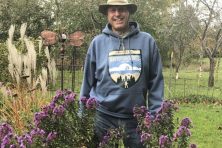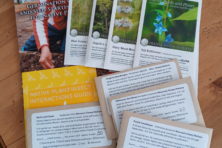Wild Ones: Don’t Be an April Fool in the Garden
- Share
- Tweet
- Pin
- Share
No gardener wants to be a fool, and the garden is – according to some historians – the origin of April Fools’ Day. Supposedly, folks were called “April fools” if they were gullible enough to believe that the spring equinox meant winter was over, only to be taken by surprise by an April snowstorm.
Other scholars suggest that April Fools’ Day dates back to 1582. Until that year, April 1 was considered the beginning of the year, which made sense because in most years, it was the beginning of the growing season.
Back in the Middle Ages, Europeans used the Julian calendar, which lacked a leap year, and through the centuries, the dates of the growing season and Easter tended to drift. To solve the problem, Pope Gregory XIII – or, more accurately, astronomers Christopher Clavius and Aloysius Lilius – introduced the Gregorian calendar.
That solved the problem of drifting seasons for Catholics, though not for those of Eastern Orthodox and Jewish faiths. The pope also decreed that New Year’s Day would be Jan. 1.
In those days, the information highway was made of cobblestone. Apparently, for several years, French peasants failed to get the message, and people who continued to celebrate the new year on April 1 were ridiculed as “April fools.”
But I’m thinking that if those French peasants were able to grow enough food to feed their families and pay the landlord, then they were no fools after all – knowing better than to plant their seeds or transplant their seedlings before the soil was warm enough to stimulate growth.
I’m afraid too many Door County home gardeners are April fools. Early spring planting may be good for trees and shrubs, and there are a few cool-weather vegetables such as greens and radishes that thrive in the early spring. But most flowers and veggies need warmth. And that includes native plants.
People may assume that if native species are adapted to our climate, then obviously, one can pop them in the ground and they will do just fine.
“April Fools!”
Non-native plants – weeds – seem to grow without effort, but alas, desirable plants usually require some work, even if they are native to this area. If you’re just starting to go native and want to see blossoms this year (or, more likely, next year), then purchasing seedlings, or plugs, is the best way to go.
Native-plant companies sometimes ship wildflowers before they’ve come out of dormancy. These plants look dead on arrival, but they can be planted right away and will do just fine. Working with actively growing seedlings, however, whether you have started them from seed or purchased them from a store or nursery – and that includes native wildflowers – usually requires “hardening” the seeds and transplanting only after the soil is warm enough.
There’s a reason the term “hothouse flower” has come to mean “fragile and vulnerable.” Plants raised in a greenhouse or even a sheltered area are pampered and often not hardy enough to grow in harsh natural conditions. Seedlings that have been raised in a greenhouse or shipped in a box will likely suffer transplant shock unless they’ve been hardened. One horticulture article called hardening “boot camp for plants.”
The idea is to gradually introduce the tender seedlings to the sun and wind. The key is gradual. On the first mild day, set the young plants outside, preferably in a shady, protected spot for just a couple hours.
Then for the next few days, expose them to the sun and breezes, each day increasing the time. It also doesn’t hurt to let them dry out a little during this period.
After five or so days, lengthen the time until the plants are used to outdoor conditions and can stay out all day and all night. Of course, during this period, the plants should still be protected during sudden rain storms or cold snaps.
Unless you enjoy lugging plants around, the easiest way to carry out the hardening is to put the plants in a wagon or cart and wheel them in and out of a garage or shed.
Finally, when the plants are hardened and the soil is warm, you can transplant them. Waiting until the soil is warm enough is important, whether a seeding is native or not.
Several local nurseries harden plants and display them outdoors, and these seedlings can be planted right away. Ask when you purchase plants whether they’ve already been hardened.
Hardening plants takes effort. Waiting to plant is frustrating. But knowing that your plants are more likely to thrive – and give you joy for years to come – makes a little up-front effort and proper timing worthwhile.
Coggin Heeringa is the president of Wild Ones of the Door Peninsula and the program director and naturalist at Crossroads at Big Creek in Sturgeon Bay.




